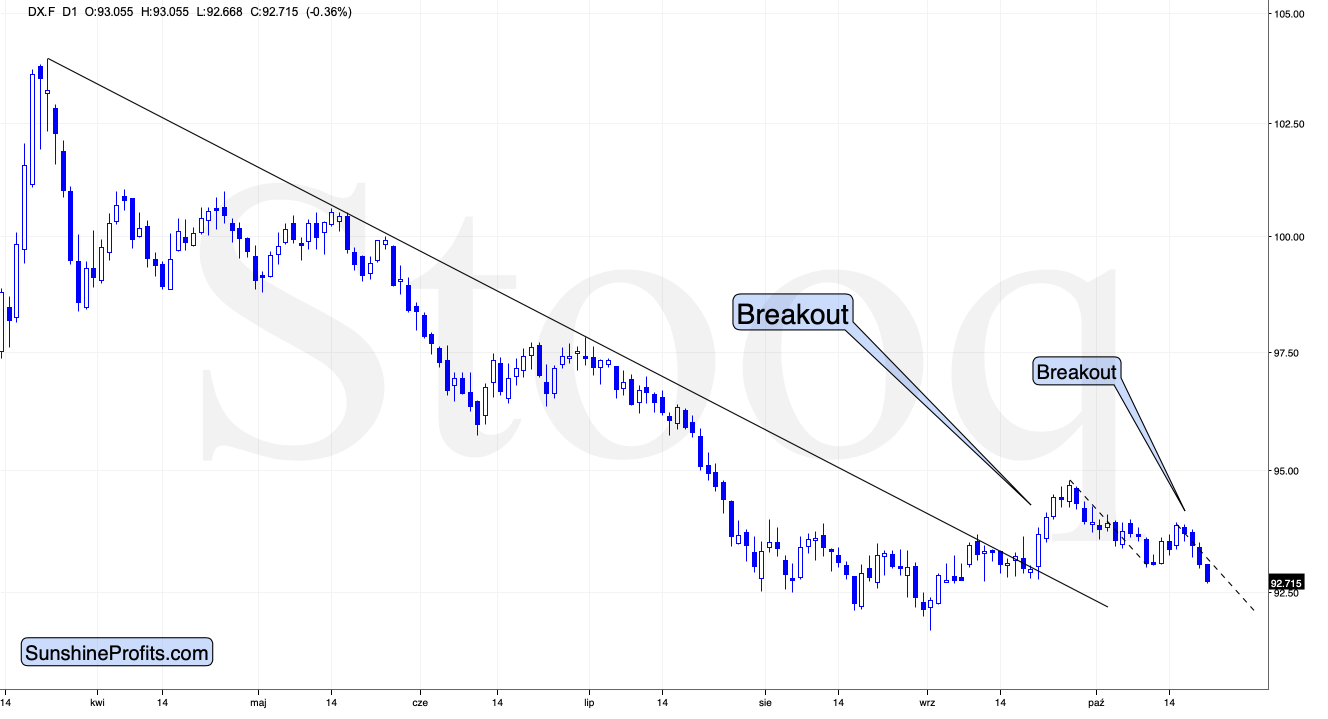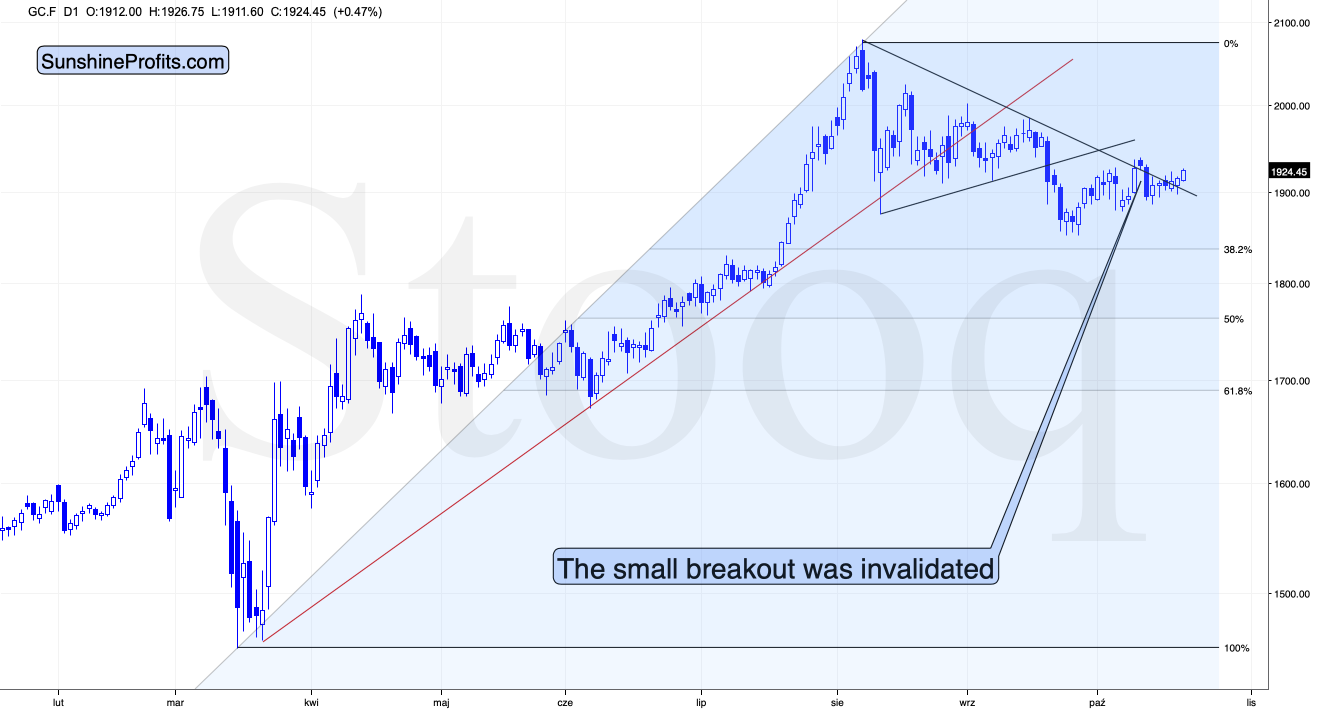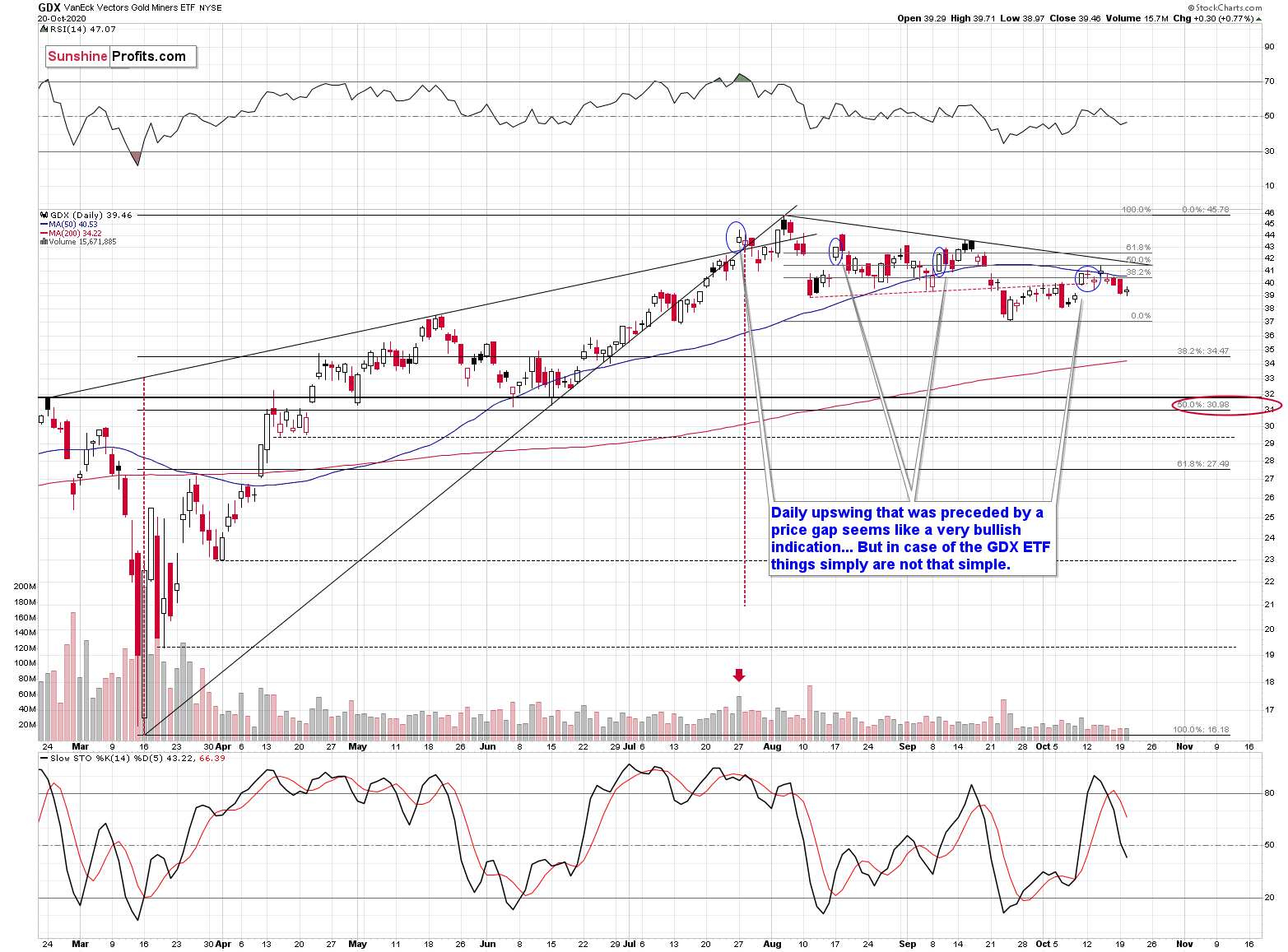Briefly: in our opinion, full (300% of the regular position size) speculative short positions in mining stocks are justified from the risk/reward point of view at the moment of publishing this Alert.
The current precious metals market movements may seem boring (and to be honest, it actually is, observed from a short-term perspective). However, there are some important and rather interesting indications in this sideways movement.
Yesterday, I commented on gold's strength regarding the USD Index and the mining stocks' strength in relation to gold. Both were weak, which resulted in a bearish combination. So, did yesterday’s and today’s pre-market movements validate or invalidate these observations?
In short, they’ve confirmed them. Despite its recent very short-term breakout, the USD Index moved lower, moving to new short-term lows.
How much did things change? Hardly anything changed. What matters the most is the breakout above the declining medium-term resistance line. More significant than it initially seemed, the post-breakout consolidation is still just that – a post-breakout consolidation. This means that the USD Index will most likely rally significantly anyway.
However, if we consider the next few days, the USDX could move lower, perhaps as low as 92. This target presupposes that the pullback could take the classic zig-zag form, where the two short-term declines are alike. The aforementioned is marked with dashed lines on the chart above.
At the same time, this would take the USDX close to its September lows, which would complete the broad bottom formation. It’s important to note that this final bottom would take place after the USD Index had already broken above the declining medium-term resistance line – that’s what increases the probability that this move lower would be the final part of the broad bottom and not the beginning of a new big slide.
Yes, the breakout above the declining short-term resistance line was just invalidated, and it’s not certain that the breakout above the medium-term resistance line will not be invalidated as well. But resistance lines based on more profound price extremes and formed over a longer timespan are more important. Consequently, just because the very short-term breakout failed to hold, doesn’t mean that the breakout above the medium-term line will also fail. Conversely, it’s a bullish factor that remains intact.
Now, the USD Index moved below its previous October lows. So, in response to the above, did the yellow metal move above its October highs as well?
It didn’t. Instead, it has just made another attempt to break above the declining resistance line. Now, if the US Index declines further, it might be successful in this attempt. But I wouldn’t count on it too much. After all, the previous effort was invalidated relatively quickly.
Let’s also keep in mind that the USD Index moved below its October lows only in today’s pre-market trading. It could be the case that it invalidates this small breakdown and rallies right away, thus triggering a decline in gold as a result.
Right now, it seems that this is the outcome that mining stocks favor.
Looking at the miners alone, one wouldn’t probably say that they are moving higher this week.
They closed higher yesterday, but it was a move higher by just $0.30, which is hardly anything compared to the previous days’ decline and the upswing in gold and the USDX downswing.
In other words, we saw yet another bearish confirmation from the miners, as they were once again weak.
This means that even if gold rallies due to the USD Index declines, miners’ upswing would probably be limited. And on the other hand, if gold declines due to USD’s rally, miners would likely drop significantly.
At the same time, let’s keep in mind that gold itself didn’t magnify USDX’s bullish signals, but instead, it magnified the bearish ones.
All in all, given the limited bullish and the sizable bearish potentials, from today’s point of view, the bearish outlook for the mining stocks continues to be justified.
Overview of the Upcoming Decline
As far as the current overview of the upcoming decline is concerned, I think it has already begun.
During the final part of the slide (which could end later than in 6 weeks, perhaps near the end of the year – just like it happened in 2015), we expect silver to decline more than miners. That would align with how the markets initially reacted to the Covid-19 threat.
The impact of all the new rounds of money printing in the U.S. and Europe on the precious metals prices is incredibly positive in the long run, which does not make the short-term decline improbable. Markets can and will get ahead of themselves and decline afterward – sometimes very profoundly – before continuing with their upward climb.
The plan is to exit the current positions in miners after they decline far and fast, but at the same time, silver drops just “significantly” (we expect this to happen in 0 – 5 weeks). In other words, the decline in silver should be severe, but the decline in the miners should look “ridiculous”. That’s what we did in March when we bought practically right at the bottom. It is soft, but at the same time, a broad instruction, so additional confirmations are necessary.
I expect this confirmation to come from gold, reaching about $1,800. If – at the same time – gold moves to about $1,800 and miners are already after a ridiculously big drop (say, to $31 - $32 in the GDX ETF – or lower), we will probably exit the short positions in the miners and at the same time enter short positions in silver. It will be tempting to wait with opening the short position in silver until the entire sector rebounds, but such a rebound could last only a couple of hours, so it would be challenging to execute such a strategy successfully.
The precious metals market's final bottom is likely to take shape when gold shows significant strength relative to the USD Index. It could take the form of a gold’s rally or a bullish reversal, despite the ongoing USD Index rally.
Summary
Summing up, given the recent move higher in the general stock market, it could be the case that the decline is delayed, but there also signs pointing to the corrective upswing being already over, just like the recent invalidation of the gold breakout and the very recent verification of the breakout in the USD Index.
Considering gold's breakout invalidation above the 2011 highs, it's evident that the big rally (that ended $4 above our upside target) is entirely over. Given this invalidation and the confirmed USD Index breakout, gold will probably slide much lower over the next few weeks. There are indications that the corrective upswing in the precious metals market and the pullback in the USDX are close to being over, so the decline could resume any day – or hour – now.
Naturally, everyone's trading is their responsibility. But in our opinion, if there ever was a time to either enter a short position in the miners or increase its size if it was not already sizable, it's now. We made money on the March decline, and on the March rebound, with another massive slide already underway.
After the sell-off (that takes gold to about $1,700 or lower), we expect the precious metals to rally significantly. The final decline might take as little as 1-6 weeks, so it's important to stay alert to any changes.
Most importantly, please stay healthy and safe. We made a lot of money on the March decline and the subsequent rebound (its initial part) price moves (and we'll likely earn much more in the following weeks and months), but you have to be healthy to enjoy the results.
As always, we'll keep you - our subscribers - informed.
To summarize:
Trading capital (supplementary part of the portfolio; our opinion): Full speculative short positions (300% of the full position) in mining stocks is justified from the risk to reward point of view with the following binding exit profit-take price levels:
Senior mining stocks (price levels for the GDX ETF): binding profit-take exit price: $32.02; stop-loss: none (the volatility is too big to justify a SL order in case of this particular trade); binding profit-take level for the DUST ETF: $28.73; stop-loss for the DUST ETF: none (the volatility is too big to justify a SL order in case of this particular trade)
Junior mining stocks (price levels for the GDXJ ETF): binding profit-take exit price: $42.72; stop-loss: none (the volatility is too big to justify a SL order in case of this particular trade); binding profit-take level for the JDST ETF: $21.22; stop-loss for the JDST ETF: none (the volatility is too big to justify a SL order in case of this particular trade)
For-your-information targets (our opinion; we continue to think that mining stocks are the preferred way of taking advantage of the upcoming price move, but if for whatever reason one wants / has to use silver or gold for this trade, we are providing the details anyway. In our view, silver has greater potential than gold does):
Silver futures downside profit-take exit price: unclear at this time - initially, it might be a good idea to exit, when gold moves to $1,703.
Gold futures downside profit-take exit price: $1,703
Long-term capital (core part of the portfolio; our opinion): No positions (in other words: cash
Insurance capital (core part of the portfolio; our opinion): Full position
Whether you already subscribed or not, we encourage you to find out how to make the most of our alerts and read our replies to the most common alert-and-gold-trading-related-questions.
Please note that we describe the situation for the day that the alert is posted in the trading section. In other words, if we are writing about a speculative position, it means that it is up-to-date on the day it was posted. We are also featuring the initial target prices to decide whether keeping a position on a given day is in tune with your approach (some moves are too small for medium-term traders, and some might appear too big for day-traders).
Additionally, you might want to read why our stop-loss orders are usually relatively far from the current price.
Please note that a full position doesn't mean using all of the capital for a given trade. You will find details on our thoughts on gold portfolio structuring in the Key Insights section on our website.
As a reminder - "initial target price" means exactly that - an "initial" one. It's not a price level at which we suggest closing positions. If this becomes the case (like it did in the previous trade), we will refer to these levels as levels of exit orders (exactly as we've done previously). Stop-loss levels, however, are naturally not "initial", but something that, in our opinion, might be entered as an order.
Since it is impossible to synchronize target prices and stop-loss levels for all the ETFs and ETNs with the main markets that we provide these levels for (gold, silver and mining stocks - the GDX ETF), the stop-loss levels and target prices for other ETNs and ETF (among other: UGLD, DGLD, USLV, DSLV, NUGT, DUST, JNUG, JDST) are provided as supplementary, and not as "final". This means that if a stop-loss or a target level is reached for any of the "additional instruments" (DGLD for instance), but not for the "main instrument" (gold in this case), we will view positions in both gold and DGLD as still open and the stop-loss for DGLD would have to be moved lower. On the other hand, if gold moves to a stop-loss level but DGLD doesn't, then we will view both positions (in gold and DGLD) as closed. In other words, since it's not possible to be 100% certain that each related instrument moves to a given level when the underlying instrument does, we can't provide levels that would be binding. The levels that we do provide are our best estimate of the levels that will correspond to the levels in the underlying assets, but it will be the underlying assets that one will need to focus on regarding the signs pointing to closing a given position or keeping it open. We might adjust the levels in the "additional instruments" without adjusting the levels in the "main instruments", which will simply mean that we have improved our estimation of these levels, not that we changed our outlook on the markets. We are already working on a tool that would update these levels daily for the most popular ETFs, ETNs and individual mining stocks.
Our preferred ways to invest in and to trade gold along with the reasoning can be found in the how to buy gold section. Furthermore, our preferred ETFs and ETNs can be found in our Gold & Silver ETF Ranking.
As a reminder, Gold & Silver Trading Alerts are posted before or on each trading day (we usually post them before the opening bell, but we don't promise doing that each day). If there's anything urgent, we will send you an additional small alert before posting the main one.
Thank you.
Sincerely,
Przemyslaw Radomski, CFA
Editor-in-chief, Gold & Silver Fund Manager






